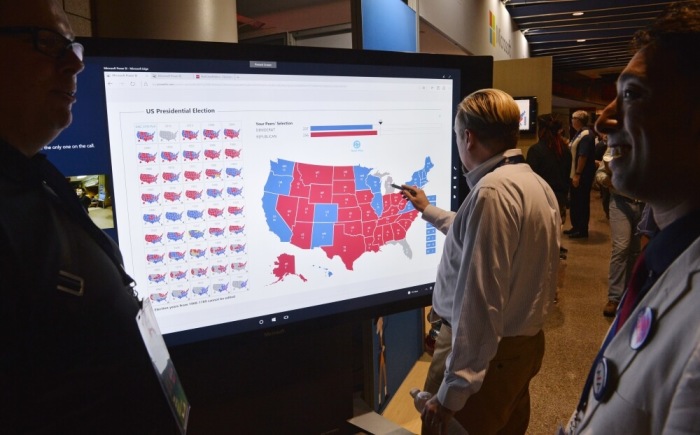Red states gain House seats at the expense of blue states in census reapportionment

Following the 2020 U.S. Census, several states that voted Republican in the 2020 presidential election are set to gain seats in Congress, while several Democrat-leaning states will lose seats.
The U.S. Census Bureau announced Monday that the results of the 2020 census were delivered to President Joe Biden. Data from the census is used in the decennial reapportionment process, where the 435 seats in the House of Representatives are distributed among the 50 states based on population.
Additionally, the Census Bureau announced how many seats each state would receive in the House based on the 2020 population figures. New congressional districts based on the population figures for each state will go into effect for the 118th U.S. Congress, scheduled to convene on Jan. 3, 2023.
Texas, which gained nearly 3 million residents since the 2010 census, will have two additional seats in Congress. The states of Colorado, Florida, Montana, North Carolina and Oregon will gain one seat apiece.
Among the states that will gain representation in Congress, four voted for former President Donald Trump in the 2020 presidential election while two voted for Biden. Five of the seven new seats created due to the 2020 census will go to states that voted for Trump.
Meanwhile, California, Illinois, Michigan, New York, Ohio, Pennsylvania and West Virginia will each lose one seat in Congress. Five of the seven states slated to lose representation in Congress voted for Biden while Ohio and West Virginia supported Trump.
The redistricting cycle comes as Republicans look to retake control of the House after coming up five seats short in 2020.
The addition of seats in states that favor Republicans could help the GOP reclaim the House majority.
Individual states have the responsibility to draw congressional districts based on the 2020 population figures, with the goal of ensuring that each district within a state has roughly equal populations.
As noted by Loyola Law School, the method for drawing districts varies from state to state, with some states giving that responsibility to the state legislature. In contrast, other states rely on independent, nonpartisan commissions to draw their districts.
Based on the makeup of state legislatures and governors’ offices following the 2020 election, Republicans will have complete control of the redistricting process in 19 states: Alabama, Arkansas, Florida, Georgia, Indiana, Iowa, Kansas, Kentucky, Mississippi, Missouri, New Hampshire, North Carolina, Ohio, Oklahoma, South Carolina, Tennessee, Texas, Utah and West Virginia.
While Nebraska has a nominally nonpartisan, unicameral legislature, a majority of its members are registered Republicans. The aforementioned states will have a combined 187 seats in the 118th Congress, accounting for approximately 43% of the total.
Meanwhile, Democrats will have complete control of the redistricting process in Illinois, Maryland, Massachusetts, Nevada, New Mexico, New York, Oregon and Rhode Island. Those states will have 75 seats in the 118th Congress.
Louisiana, Minnesota, Pennsylvania and Wisconsin currently have divided state governments, with one party occupying the governor’s office and the other party controlling one or both houses of the state legislature. As a result, congressional maps in these states will require bipartisan support.
Independent commissions will draw congressional districts in Arizona, California, Colorado, Idaho, Michigan, Montana and Washington, states that will have 94 seats in the 118th Congress.
Hawaii, New Jersey and Virginia will rely on politician commissions, which will consist of legislators and community members, to draw their districts. These states will have a combined 27 seats in the 118th Congress.
While the responsibility of drawing districts in Connecticut belongs to the state legislature, maps must secure the support of two-thirds of its members to pass.
Although Democrats have complete control of the state government, they do not have the two-thirds majority required to pass a map without Republican support. A backup commission consisting of members appointed by leaders of both parties will draw the state’s five congressional districts if the legislature fails to produce a map.
Congressional maps in Maine must also secure the support of two-thirds of each state legislative chamber. Democrats control both chambers but fall short of a two-thirds majority. An advisory commission consisting of members appointed by leaders of both parties assists the legislature in drawing the state’s two congressional districts.
The remaining six seats will be distributed among the least populous states in the country, with one seat apiece.
In addition to affecting the composition in the House of Representatives, the reapportionment of congressional seats will also have an impact on the makeup of the Electoral College, where each state is assigned electoral votes based on its combined number of representatives and senators.
States slated to gain representation in Congress will also gain representation in the Electoral College in the 2024 presidential election. States that will lose seats in Congress will see their influence in the Electoral College diminish.
Overall, the 2020 census found that over 331 million people lived in the U.S. as of April 1, 2020, an increase of over 22 million people from the 2010 census.
“Our work doesn’t stop here,” said Census Bureau Acting Director Ron Jarmin. “Now that the apportionment counts are delivered, we will begin the additional activities needed to create and deliver the redistricting data that were previously delayed due to COVID-19.”
The aforementioned redistricting data refers to the population counts for counties, cities and precincts that states need to create districts of equal population. According to the Census Bureau, “States are expected to receive redistricting data by August 16, and the full redistricting data with toolkits for ease of use will be delivered by September 30.”





























